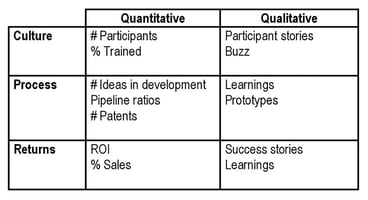Metrics strategy is a vital topic relative to innovation. Despite how important metrics strategy is, it's a challenging one for many businesses when it comes to innovation. Going back through my own experiences and secondary research on the topic, here are a few starting thoughts on developing what we call a "whole-brain" approach:
Begin developing your innovation metrics strategy by determining what factors drive ROI.
Specifically identify which factors increase positive business returns and which reduce necessary investment. Starting with the end result in mind will better align the overall effort toward delivering a positive return on investment.
Adopt a "whole-brain metrics" orientation.
This means consciously trying to capture both quantitative (left brain) and qualitative (right brain) metrics. Doing so, you satisfy the financial and performance-oriented need for numerical targets and tracking. Adding qualitative measures into the equation, however, also provides the basis to match the numbers with stories, images, and other insights, providing a more complete performance picture.
Within the whole-brain approach, consider three distinct types of metrics related to innovation.
- Culture Metrics - If your innovation efforts are part of an overall push to instill a more innovative approach to a department, business unit, or company, culture-based measures help track how solidly the effort has taken hold. Quantitative metrics in this area may be more activity-oriented, i.e., how many people are participating in innovation efforts and what percent of employees have been trained in creative or strategic thinking disciplines. Qualitative elements can tie to success stories on personal & professional development or other workplace-based changes.
- Process Metrics - The second group of measures relate to systematic innovation activities. Quantitatively, it could be how many ideas have been developed or are in various parts of the innovation pipeline. Longer term, it could incorporate how many patents have been filed and received. Qualitative measures in this area might relate to process learnings or images / descriptions of prototypes developed through innovation efforts.
- Return-Based Metrics - The third group includes ROI, ROC, new products/services as a percent of sales, etc. Here too though, it's important to augment the quantitative measures with qualitative elements, such as success stories, learnings (from both successes and mistakes), and customer comments (letters, email, online and social media-based responses, etc.).
This is hardly an exhaustive treatment on innovation metrics strategy, but it can be a good starter for expanding what you're doing now. If, however, you're doing more currently in this area, then please share what's working for you. - Mike Brown




